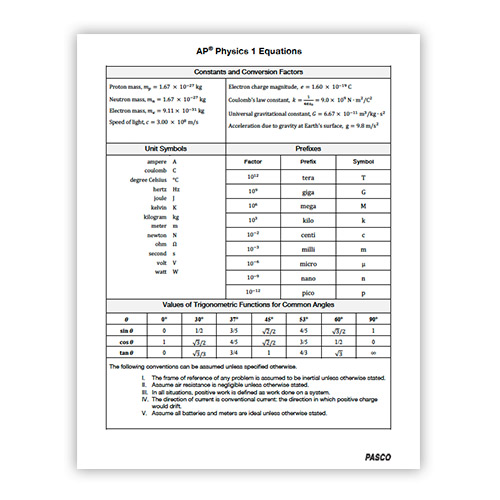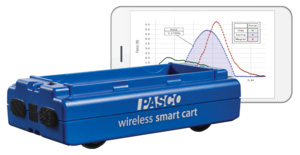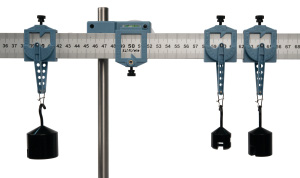The laboratory portion of the College Board AP® Physics 1 course is a crucial component of preparing students for the AP Physics 1 exam. For students, these hands-on experiences help connect concepts to the real world while equipping them with the scientific inquiry, reasoning, and critical thinking skills for future success.

Advanced Physics 1 Lab Manual
Transform abstract topics into tangible, phenomena-based investigations with fifteen guided inquiry labs for AP Physics 1.
Authored by physics educators, the Advanced Physics 1 Lab Manual, includes fifteen guided inquiry labs that cover AP Physics 1 topics such as kinematics and dynamics, circular motion and gravitation, energy and momentum, torque, and rotational motion.
AP Physics 1 Course Alignment
Each investigation addresses at least one Learning Objective and Science Practice for Advanced Placement® Physics, as outlined in the College Board AP® Physics 1: Algebra-Based Course and Exam Description.
This page provides AP Physics 1 alignment details for the labs inside PASCO’s Advanced Physics 1 Lab Manual. A complete list of applicable AP Physics 1 Big Ideas, Learning Objectives, and Science Practices is provided for each lab.
Need a quick guide?

Download the AP Physics 1 Alignment Sheet.

Download the Equation Sheet for AP Physics 1.
Advanced Physics 1 Lab Manual Lab Titles
| 1 - Graphing Motion | 9 - Momentum and Impulse |
| 2 - Newton’s Second Law | 10 - Rotational Dynamics |
| 3 - Atwood’s Machine | 11 - Rotational Statics |
| 4 - Coefficients of Friction | 12 - Periodic Motion: Mass and Spring |
| 5 - Two-Dimensional Motion: Projectiles | 13 - Simple Pendulum |
| 6 - Conservation of Mechanical Energy |
The Advanced Physics 1 Lab Manual also includes two additional labs: Resonance and Standing Waves and DC Circuits. These experiments align more closely with topics in the AP® Physics 2 Course Description, which underwent updates in Fall 2020. |
| 7 - Work and Kinetic Energy | |
| 8 - Conservation of Momentum | |
| Three Levels of Scientific Inquiry | |
|
Each investigation is provided in three formats—Structured, Guided Inquiry, and Student Designed—allowing you to choose the level of inquiry that’s right for your physics course. All versions include identical Analysis and Synthesis Questions designed to help prepare students for the AP Physics 1 exam.
|
|
Graphing Motion
How are the graphs of position versus time, velocity versus time, and acceleration versus time for an object moving with constant acceleration related? In this lab, students measure the position and velocity of a dynamics cart to determine the relationships between graphs of position, velocity, and acceleration versus time for an object undergoing constant acceleration.
| Prerequisites |
|
| Big Idea | Force Interactions (INT) |
| Learning Objectives |
3.A.1.1: Express the motion of an object using narrative, mathematical, and graphical representations. 3.A.1.2: Design an experimental investigation of the motion of an object. 3.A.1.3: Analyze experimental data describing the motion of an object and be able to express the results of the analysis using narrative, mathematical, and graphical representations. |
| Science Practices | 1.5, 2.1, 2.2, 4.2, 5.1 |
Teaching Tools
Wireless Motion Sensor
Capture and display motion data in real time with the Wireless Motion Sensor.Newton’s Second Law
What factors affect the acceleration of an object or system? In this lab, students use a Smart Cart to determine the relationship between a system’s mass, acceleration, and the net force being applied to the system.
In this activity, the system of interest consists of two masses that are mechanically connected by a thread. Applying a net force to the system causes changes in the motion of both objects.
| Prerequisites |
|
| Big Idea | Force Interactions (INT) |
| Learning Objectives |
3.B.1.1: Predict the motion of an object subject to forces exerted by several objects using an application of Newton’s second law in a variety of physical situations, with acceleration in one dimension. 3.B.1.2: Design a plan to collect and analyze data for motion (static, constant, or accelerating) from force measurement, and carry out an analysis to determine the relationship between the net force and the vector sum of the individual forces. 3.B.1.3: Re-express a free-body diagram into a mathematical representation, and solve the mathematical representation for the acceleration of the object. 3.B.2.1: Create and use free-body diagrams to analyze physical situations to solve problems with motion qualitatively and quantitatively. |
| Science Practices | 1.1, 1.4, 1.5, 2.2, 4.2, 5.1, 6.4, 7.2 |
Teaching Tools
Looking for AP Physics 1 equipment?
Perform all fifteen Advanced Physics 1 labs—plus many others—with our expandable Physics Lab Stations.Atwood’s Machine
For two masses involved in an Atwood’s machine, how does the total mass and the difference between the masses affect their acceleration? In this experiment, students use a photogate and pulley system to determine the mathematical relationship between the acceleration of an Atwood’s machine, the difference between its two masses, and the sum of those two masses.
| Prerequisites |
|
| Big Idea | Force Interactions (INT) |
| Learning Objectives |
3.B.1.1: Predict the motion of an object subject to forces exerted by several objects using an application of Newton’s second law in a variety of physical situations, with acceleration in one dimension. 3.B.1.2: Design a plan to collect and analyze data for motion (static, constant, or accelerating) from force measurement, and carry out an analysis to determine the relationship between the net force and the vector sum of the individual forces. |
| Science Practices | 4.2, 5.1, 6.4, 7.2 |
Teaching Tools
Super Pulley with Clamp
Easily create an Atwood machine in your lab using the PASCO Super Pulley with Clamp.Coefficients of Friction
How are the coefficients of kinetic and static friction between two surfaces determined? In this experiment, students use a dynamics cart to determine the static and kinetic friction coefficients between two contacting surfaces.
| Prerequisites |
|
| Big Idea | Force Interactions (INT) |
| Learning Objectives |
3.C.4.1: Make claims about various contact forces between objects based on the microscopic cause of these forces. 3.C.4.2: Explain contact forces (tension, friction, normal, buoyant, spring) as arising from interatomic electric forces and that they therefore have certain directions. |
| Science Practices | 6.1, 6.2 |
Two-Dimensional Motion: Projectiles
What is the range of a projectile launched horizontally? In this experiment, students use a photogate and a mini launcher to measure the variables that affect the two-dimensional motion of a projectile launched horizontally. Then, they use those variables to accurately predict and test the projectile’s horizontal range.
| Prerequisites |
|
| Big Idea | Force Interactions (INT) |
| Learning Objectives |
3.E.1.3: Use force and velocity vectors to determine qualitatively or quantitatively the net force exerted on an object and qualitatively whether the kinetic energy of that object would increase, decrease, or remain unchanged. 3.E.1.4: Apply mathematical routines to determine the change in kinetic energy of an object given the forces on the object and the displacement of the object. |
| Science Practices | 1.4, 2.2 |
Teaching Tools
PASCO Mini Launcher
Demonstrate the independence of X and Y motion while capturing student attention with the PASCO Mini Launcher!Conservation of Mechanical Energy
How do the potential and kinetic energies of a closed system in motion change when a conservative force is applied? In this investigation, students use a Smart Cart and a dynamics track to explore how the kinetic energy, gravitational potential energy, and total mechanical energy of a cart/earth system changes as the cart rolls down an inclined track.
| Prerequisites |
|
| Big Idea | Conservation (CON) |
| Learning Objectives |
5.B.4.1: Describe and make predictions about the internal energy of systems. 5.B.4.2: Calculate changes in kinetic energy and potential energy of a system using information from representations of that system. |
| Science Practices | 1.4, 2.1, 2.2, 6.4, 7.2 |
Work and Kinetic Energy
How is the work done on an object by a force related to the change in that object’s kinetic energy? In this lab, students use a Smart Cart dynamics system to investigate the relationship between the change in kinetic energy of an object experiencing a nonzero net force and the work done by that net force on the object. Then, students use their experimental data to establish a measurement-based relationship between work and kinetic energy.
| Prerequisites |
|
| Big Idea | Change (CHA) |
| Learning Objectives |
4.C.2.1: Make predictions about the changes in the mechanical energy of a system when a component of an external force acts parallel or antiparallel to the direction of the displacement of the center of mass. 4.C.2.2: Apply the concepts of conservation of energy and the work-energy theorem to determine qualitatively and/or quantitatively that work done on a two-object system in linear motion will change the kinetic energy of the center of mass of the system, the potential energy of the systems, and/or the internal energy of the system. |
| Science Practices | 1.4, 2.2, 6.4, 7.2 |
Teaching Tools
Enhance your physics labs with the patented Smart Cart
Make live measurements of force, position, velocity, and acceleration—on or off track!Conservation of Momentum
How does a collision affect the total linear momentum and kinetic energy of a two-object system? In this investigation, students use a Smart Cart dynamics system to demonstrate the conservation of linear momentum and kinetic energy in an elastic collision. They compare their results with those from an inelastic collision, finding that linear momentum is conserved, but kinetic energy is not.
| Prerequisites |
|
| Big Idea | Conservation (CON) |
| Learning Objectives |
5.D.1.3: Apply mathematical routines appropriately to problems involving elastic collisions in one dimension and justify the selection of those mathematical routines based on conservation of momentum and restoration of kinetic energy. 5.D.2.2: Plan data-collection strategies to test the law of conservation of momentum in a two-object collision that is elastic or inelastic and analyze the resulting data graphically. 5.D.2.4: Analyze data that verify conservation of momentum in collisions with and without an external frictional force. |
| Science Practices | 2.1, 2.2, 4.1, 4.2, 4.4, 5.1, 5.3 |
Teaching Tools
PASCO Physics Lab Stations
Explore energy, conservation of momentum, and more with PASCO Physics Lab Stations.Momentum and Impulse
How is the impulse imparted to an object in a collision related to the object’s change in momentum? In this lab, students investigate the relationship between the change in momentum of a cart undergoing a collision and the impulse imparted to the cart to change its momentum. They use their trial data to establish a measurement-based relationship between change in momentum and impulse.
| Prerequisites |
|
| Big Idea | Force Interactions (INT) |
| Learning Objectives |
3.D.2.3: Analyze data to characterize the change in momentum of an object from the average force exerted on the object and the interval of time during which the force is exerted. 3.D.2.4: Design a plan for collecting data to investigate the relationship between changes in momentum and the average force exerted on an object over time. |
| Science Practices | 4.2, 5.1 |
Teaching Tools
PASCO Dynamics Systems
Equip your lab for less with PASCO Dynamics Systems! Visit the Dynamics System Configuration Guide to find your ideal system in five minutes or less.Rotational Dynamics
How does net torque affect the angular acceleration of an object rotating with constant rotational inertia? In this experiment, students use a rotary motion sensor to determine the mathematical relationship between torque, rotational inertia, and the angular acceleration of a rotating object.
| Prerequisites |
|
| Big Idea | Force Interactions (INT) |
| Learning Objectives |
3.F.2.1: Make predictions about the change in the angular velocity about an axis for an object when forces exerted on the object cause a torque about that axis. 3.F.2.2: Plan data-collection and analysis strategies designed to test the relationship between a torque exerted on an object and the change in angular velocity of that object about an axis. 3.A.1.3: Analyze experimental data describing the motion of an object and be able to express the results of the analysis using narrative, mathematical, and graphical representations. |
| Science Practices | 4.1, 4.2, 5.1, 5.4 |
Teaching Tools
Wireless Rotary Motion Sensor
Bring live measurements to a variety of rotational motion labs with the Wireless Rotary Motion Sensor.Rotational Statics
What is the net force and net torque of an object in static equilibrium? In this investigation, students use the Smart Cart’s force sensor and tension protractors to demonstrate that the sum of the forces acting on an object in static translational equilibrium is equal to zero. Similarly, the sum of the torques acting on an object in static rotational equilibrium is also equal to zero.
| Prerequisites |
Students should be familiar with these concepts:
|
| Big Idea | Force Interactions (INT) |
| Learning Objectives |
3.F.1.1: Use representations of the relationship between force and torque. 3.F.1.2: Compare the torques on an object caused by various forces. 3.F.1.3: Estimate the torque on an object caused by various forces in comparison with other situations. 3.F.1.4: Design an experiment and analyze data testing a question about torques in a balanced rigid system. 3.F.1.5: Calculate torques on a two-dimensional system in static equilibrium by examining a representation or model (such as a diagram or physical construction). |
| Science Practices | 1.4, 2.2, 2.3, 4.1, 4.2, 5.1 |
Teaching Tools
Meter Stick Torque Set
Investigate torque, rotational statics, and more with our award-winning Meter Stick Torque Set.Periodic Motion: Mass and Spring
What variables affect the period of oscillation for a mass and spring system? In this experiment, students use a Smart Cart to determine the physical properties of a vertical mass and spring system that affect its period of oscillation. Then, they use their data to support a mathematical model of the relationship between period, mass, and spring constant.
| Prerequisites |
Students should be familiar with these concepts:
|
| Big Idea | Force Interactions (INT) |
| Learning Objectives |
3.B.3.1: Predict which properties determine the motion of a simple harmonic oscillator and what the dependence of the motion is on those properties. 3.B.3.2: Design a plan and collect data in order to ascertain the characteristics of the motion of a system undergoing oscillatory motion caused by a restoring force. 3.B.3.3: Analyze data to identify qualitative and quantitative relationships between given values and variables (i.e., force, displacement, acceleration, velocity, period of motion, frequency, spring constant, string length, mass) associated with objects in oscillatory motion and use those data to determine the value of an unknown. 3.B.3.4: Construct a qualitative and/or quantitative explanation of oscillatory behavior given evidence of a restoring force. |
| Science Practices | 2.2, 4.2, 5.1, 6.2, 6.4, 7.2 |
Teaching Tools
Mass & Hanger Set
Vary mass in a variety of labs with this durable Mass & Hanger Set.Simple Pendulum
What variables affect the period of a pendulum? In this experiment, students use a photogate and pendulum to determine the physical properties of a simple pendulum that affect its period. Then, they use their data to support a mathematical model that relates period to pendulum arm length.
| Prerequisites |
Students should be familiar with these concepts:
|
| Big Idea | Force Interactions (INT) |
| Learning Objectives |
3.B.3.1: Predict which properties determine the motion of a simple harmonic oscillator and what the dependence of the motion is on those properties. 3.B.3.2: Design a plan and collect data in order to ascertain the characteristics of the motion of a system undergoing oscillatory motion caused by a restoring force. 3.B.3.3: Analyze data to identify qualitative and quantitative relationships between given values and variables (i.e., force, displacement, acceleration, velocity, period of motion, frequency, spring constant, string length, mass) associated with objects in oscillatory motion and use those data to determine the value of an unknown. |
| Science Practices | 2.2, 4.2, 5.1, 6.4, 7.2 |










